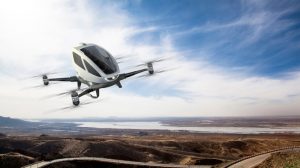The DM007 is a sub-$100 toy quadcopter with a diagonal motor size of 175mm. It comes in two variants — a WiFi FPV version with 2MP HD camera and another FPV version with 0.3MP HD camera. It is also available in black or white.
At first glance, the DM007 looks like any other toy quadcopter in its class but look closer and you’ll notice that it has significantly shorter propellers (6cm to be exact) compared to other toy drones of similar size. Look even closer and you’ll notice that those short propellers are not connected to pinion gears but are mounted directly to their respective motors. It also comes with a very large capacity 7.4V 400mAh 2-cell battery.
These are the key differences that distinguishes the DM007 from the rest.
Everything else about the drone appears insignificant. It has a sleek-looking body with built-in prop guards, a HD camera mounted on its belly and cool LED lights at its head and tail.
Specifications
- Dimensions: 185 x 205 x 70mm
- Diagonal motor distance: 175mm
- Motor size: 12mm
- Weight: 98g (with battery and camera)
- Flight time: 6 to 8 minutes
- Battery: 7.4V 400mAh 2S Li Po
- Charging time: 80 to 90 minutes
- Control distance: approximately 100m
- Transmitter power: 4 x 1.5V AA batteries (not included)
Flight Performance
As mentioned earlier, the DM007 has short propellers that are directly mounted to their motors. So how exactly does this translate to flight performance?
In multirotor design, shorter propellers generate less propulsion compared to longer ones when spinning at the same speed. In order to match the propulsion generated by longer props, shorter props need to be spinning at a higher rate. Hence, multirotors using shorter props may seem to be at a disadvantage when it comes to propulsion until you consider the bigger picture — both short and long props have their advantages and disadvantages.
Drones with longer props tend to have longer hover times (thanks to higher inertia in the props which help reduce power consumption) and higher top speeds but suffer from a lower rate of acceleration and a lack of responsiveness and agility. Drones with shorter props, as you would have guessed by now, have quite the opposite characteristics — shorter hover times, lower top speeds and better acceleration and agility in the air.
Without going into too much detail with the dynamics of multirotor design, I will just focus on the DM007’s rather unique propeller and motor configuration.
The DM007’s short propellers give it a very agile, precise and zippy feel in the air. Shorter propellers accelerate a lot faster than longer ones due to lower inertia, so the DM007 is capable of gaining speed very quickly, making quick turns and maneuvers a lot of fun. Aerial flips also feel very precise and “locked-in” since the DM007 recovers very quickly from each flip.
Although the DM007 comes with a WiFi FPV camera, I really see no point in flying it for taking pictures or videos from the air. This is one toy drone I’d pick up just for the fun of flying.
The downside to having short and fast-spinning propellers is a higher rate of power consumption. Unlike other drones with similar size that typically have single cell batteries, the DM007 comes with a massive 400mAh 2-cell battery to keep it on par with its rivals. Despite having such a huge battery, the drone manages a flight time of about 6-8 minutes which is average for its class.
FPV Camera
The DM007’s belly-mounted camera comes with a built-in WiFi FPV transmitter which means you can view the FPV (First Person View) video feed on your smartphone. This gives the experience of flying on board the drone itself.
Cool as it may seem, the FPV system here does have its flaws — video latency lag is very high due to the use of WiFi instead of 5.8GHz. This latency lag causes FPV video to have a staccato effect and appear like slideshows, especially when there is some distance between the drone and FPV monitor.
Conclusion
With its short propellers and prop guards, the DM007 makes an excellent beginners’ quadcopter, especially for children aged 9 years or older (although the company has an age recommendation of at least 14 years).
If you believe the longer and much larger propellers on popular toy quadacopters such as the Syma X5SW are anything to worry about, then you really have a point. Longer and larger propellers obviously pose a bigger threat, having the potential to cause some serious injuries which is why the DM007, with its short and well-shielded propellers, is an excellent choice for parents looking to buy a toy quadcopter for their children.
Even for adults, the DM007 is an excellent toy drone to fly around just for the fun of flying. It is highly responsive and precise in the air compared to other toy quadcopters that come with longer propellers.
The DM007, however, does have its weaknesses. For one, the battery compartment is a bit tight, fidgety and hard to access. The LED lights, although they appear sophisticated, do very little in helping with orientation since both front and rear LED lights are blue in color. Its landing legs tend to come off very easily during hard landings as well.
Despite these minor flaws, the DM007 is still overall a great toy quadcopter for beginners, particularly for children mature enough to handle RC toys.
